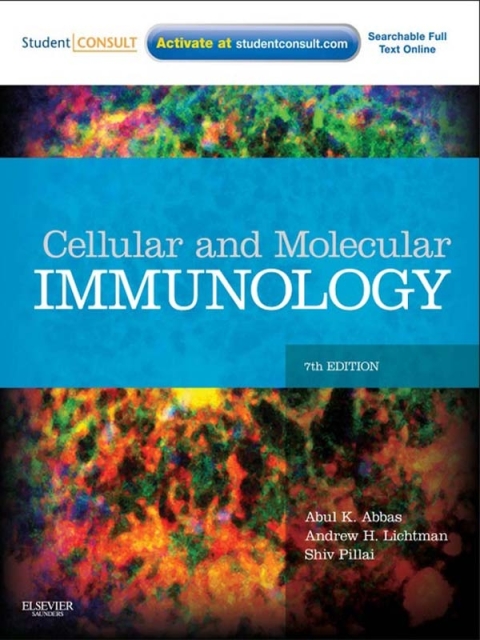Description
Efnisyfirlit
- Instructions for online access
- Cover
- Title page
- Table of Contents
- Copyright
- Dedication
- Preface
- Chapter 1: Properties and Overview of Immune Responses
- Innate and Adaptive Immunity
- Types of Adaptive Immune Responses
- Cardinal Features of Adaptive Immune Responses
- Cellular Components of the Adaptive Immune System
- Cytokines, Soluble Mediators of the Immune System
- Overview of Immune Responses to Microbes
- Summary
- Chapter 2: Cells and Tissues of the Immune System
- Cells of the Immune System
- Anatomy and Functions of Lymphoid Tissues
- Summary
- Chapter 3: Leukocyte Migration into Tissues
- Adhesion Molecules on Leukocytes and Endothelial Cells Involved in Leukocyte Recruitment
- Chemokines and Chemokine Receptors
- Leukocyte-Endothelial Interactions and Leukocyte Extravasation
- Migration of Neutrophils and Monocytes to Sites of Infection or Tissue Injury
- Migration and Recirculation of T Lymphocytes
- Migration of B Lymphocytes
- Summary
- Chapter 4: Innate Immunity
- Recognition of Microbes and Damaged Self by the Innate Immune System
- Cell-Associated Pattern Recognition Receptors of Innate Immunity
- Cellular Components of the Innate Immune System
- Soluble Recognition and Effector Molecules of Innate Immunity
- The Inflammatory Response
- The Antiviral Response
- Stimulation of Adaptive Immunity
- Feedback Mechanisms that Regulate Innate Immunity
- Summary
- Chapter 5: Antibodies and Antigens
- Antibody Structure
- Synthesis, Assembly, and Expression of Ig Molecules
- Antibody Binding of Antigens
- Structure-Function Relationships in Antibody Molecules
- Summary
- Chapter 6: Major Histocompatibility Complex Molecules and Antigen Presentation to T Lymphocytes
- Properties of Antigens Recognized by T Lymphocytes
- Antigen Capture and the Functions of Antigen-Presenting Cells
- The Major Histocompatibility Complex (MHC)
- Processing of Protein Antigens
- Presentation of Nonprotein Antigens to subsets of T Cells
- Summary
- Chapter 7: Immune Receptors and Signal Transduction
- An Overview of Signal Transduction
- The Immune Receptor Family
- The B Lymphocyte Antigen Receptor Complex
- The Attenuation of Immune Receptor Signaling
- Cytokine Receptors and Signaling
- Summary
- Chapter 8: Lymphocyte Development and Antigen Receptor Gene Rearrangement
- Overview of Lymphocyte Development
- Rearrangement of Antigen Receptor Genes in B and T Lymphocytes
- B Lymphocyte Development
- Maturation of T Lymphocytes
- Summary
- Chapter 9: Activation of T Lymphocytes
- Overview of T Lymphocyte Activation
- Signals for T Lymphocyte Activation
- Functional Responses of T Lymphocytes
- Decline of T Cell Responses
- Summary
- Chapter 10: Effector Mechanisms of Cell-Mediated Immunity
- Types of Cell-Mediated Immune Reactions
- Migration of Effector T Lymphocytes to Sites of Infection
- Effector Functions of CD4+ Helper T Cells
- Effector Functions of CD8+ Cytotoxic T Lymphocytes
- Functions of Other T Cell Subsets
- Summary
- Chapter 11: B Cell Activation and Antibody Production
- General Features of Humoral Immune Responses
- Antigen Recognition and Antigen-Induced B Cell Activation
- Helper T Cell–Dependent Antibody Responses to Protein Antigens
- Antibody Responses to T Cell–Independent Antigens
- Antibody Feedback: Regulation of Humoral Immune Responses by Fc Receptors
- Summary
- Chapter 12: Effector Mechanisms of Humoral Immunity
- Overview of Humoral Immunity
- Neutralization of Microbes and Microbial Toxins
- Antibody-Mediated Opsonization and Phagocytosis
- The Complement System
- Neonatal Immunity
- Summary
- Chapter 13: Regional Immunity: Specialized Immune Responses in Epithelial and Immune Privileged Tissues
- General Features of Immunity at Epithelial Barriers
- Immunity in the Gastrointestinal System
- Immunity in other Mucosal Tissues
- The Cutaneous Immune System
- Immune Privileged Tissues
- Summary
- Chapter 14: Immunologic Tolerance and Autoimmunity
- General Features of Immunologic Tolerance
- T Lymphocyte Tolerance
- B Lymphocyte Tolerance
- Tolerance induced by Foreign Protein Antigens
- Pathogenesis of Autoimmunity
- Summary
- Chapter 15: Immunity to Microbes
- General Features of Immune Responses to Microbes
- Immunity to Extracellular Bacteria
- Immunity to Intracellular Bacteria
- Immunity to Fungi
- Immunity to Viruses
- Immunity to Parasites
- Strategies for Vaccine Development
- Summary
- Chapter 16: Transplantation Immunology
- Immune Responses to Allografts
- Patterns and Mechanisms of Allograft Rejection
- Prevention and Treatment of Allograft Rejection
- Xenogeneic Transplantation
- Blood Transfusion and the ABO and Rh Blood Group Antigens
- Hematopoietic Stem Cell Transplantation
- Summary
- Chapter 17: Immunity to Tumors
- General Features of Tumor Immunity
- Tumor Antigens
- Immune Responses to Tumors
- Evasion of Immune Responses by Tumors
- Immunotherapy for Tumors
- The Role of the Immune System in Promoting Tumor Growth
- Summary
- Chapter 18: Hypersensitivity Disorders
- Causes of Hypersensitivity Diseases
- Mechanisms and Classification of Hypersensitivity Reactions
- Diseases Caused by Antibodies
- Diseases Caused by T Lymphocytes
- Therapeutic Approaches for Immunologic Diseases
- Selected Immunologic Diseases: pathogenesis and therapeutic strategies
- Summary
- Chapter 19: IgE-Dependent Immune Responses and Allergic Disease
- General Features of IgE-Dependent Immune Reactions
- Production of IgE
- Role of Mast Cells, Basophils, and Eosinophils in Immediate Hypersensitivity
- IgE- and Mast Cell–Dependent Reactions
- Genetic Susceptibility to Immediate Hypersensitivity
- ALLERGIC Diseases in Humans: Pathogenesis and Therapy
- The Protective Roles of IgE- and Mast Cell–Mediated Immune Reactions
- Summary
- Chapter 20: Congenital and Acquired Immunodeficiencies
- General Features of Immunodeficiency Diseases
- Congenital (Primary) Immunodeficiencies
- Acquired (Secondary) Immunodeficiencies
- Human Immunodeficiency Virus And The Acquired Immunodeficiency Syndrome
- Summary
- Glossary
- Cytokines
- Principal Features of Selected CD Molecules
- Laboratory Techniques Commonly Used in Immunology
- Index







Reviews
There are no reviews yet.